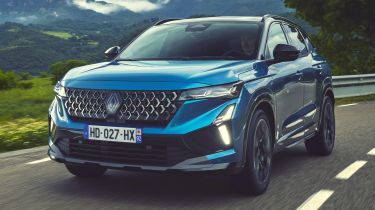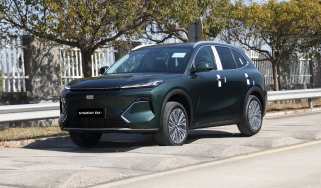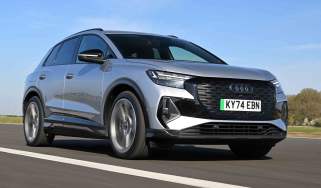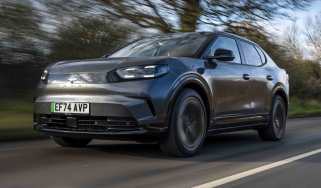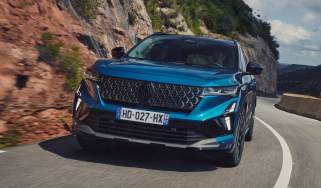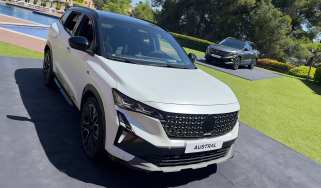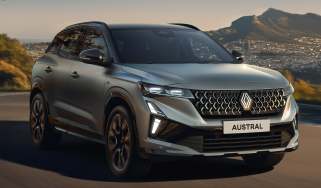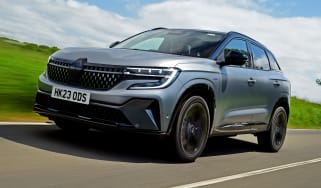Renault Austral review
The Austral’s Google tech and efficient hybrid system are rather appealing, but that’s not enough to conquer the ultra-competitive family SUV market

Our review on the Renault Austral
The Renault Austral is a family SUV defined by its tech, with a bang-up-to-date infotainment system that works really well and a hybrid powertrain that just sips fuel, which might be enough to win sales, while the level of standard equipment on offer is undoubtedly competitive. However, practicality is acceptable rather than class-leading, and the way it drives has been an issue since the Austral was launched.
We respect Renault for acknowledging the complaints made about the Austral’s poor ride quality and refinement, and working hard to correct these flaws for the newly facelifted version of the family SUV. But the company’s efforts have produced marginal improvements at best, and any progress that was made could be undone by the fact UK cars will now feature a less sophisticated suspension system. We hope to find out what effect that has on British roads very soon.
| Key specs | |
| Fuel type | Full-hybrid |
| Body style | Mid-sized SUV |
| Powertrain | 1.2-litre, 3cyl turbocharged petrol plus 1x e-motor, front-wheel drive |
| Safety | 5-star (Euro NCAP, 2022) |
| Warranty | Up to 3 years/60,000 miles |
About the Renault Austral
The Austral, introduced in 2022 as the replacement for the old Kadjar, making it the brand’s new champion in the ultra-competitive mid-sized SUV segment.
The Austral struggled to make much of an impact, because the car’s attributes were overshadowed by poor ride quality and refinement, plus an easily confused hybrid powertrain – and we weren’t the only ones to point this out. We’re told Renault began work on fixing these flaws almost as soon as people started making their thoughts known. Hence why there’s a new, heavily updated version being launched just three years after the original model arrived in showrooms.
Used - available now

2024 Renault
Austral
21,247 milesAutomaticPetrol1.2L
Cash £21,339
2025 Renault
Austral
12,726 milesAutomaticPetrol1.2L
Cash £19,997
2024 Renault
Austral
11,162 milesAutomaticPetrol1.2L
Cash £23,197
2025 Renault
Austral
15,858 milesAutomaticPetrol1.2L
Cash £20,299Every Austral will come with a long list of standard equipment. Previously, even entry-level models featured
- 19-inch alloy wheels
- 12.3-inch portrait touchscreen
- 12-inch digital instrument cluster
- Apple CarPlay and Android Auto
- Wireless charging pad
- Reversing camera
- Adaptive cruise control
- Adaptive LED headlights
- Plenty of other driver-assistance tech.
Higher-spec models add:
- 20-inch wheels
- Panoramic sunroof
- 9.3-inch head-up display
- Harman Kardon sound system
- 360-degree surround view camera
- Plus some extra safety and convenience tech, such as lane steering assistance and hands-free parking.
The Austral has only been offered with a full-hybrid powertrain since it was launched, and that’s how things are going to stay. The set-up uses a 1.2-litre three-cylinder turbocharged petrol engine and an electric motor used to drive the front wheels, with the e-motor fed by a small 2kWh battery. This allows you to move away on electric power and, according to Renault, complete up to 80 per cent of city driving without using a drop of petrol.
Renault Austral prices and latest deals
How much does the Renault Austral cost? Well, official ‘on the road’ prices range from £33,990 to £38,490 but you can currently save an average of £4,428 through the Auto Express Find A Car service, where prices start at £30,434. You can lease a Renault Austral from £315 per month or buy a used model at prices starting from £18,995.
Check out our latest new car deals, leasing deals and used car deals for the top offers available now on Auto Express. And don't forget we can help you sell your car, too.
Performance & driving experience
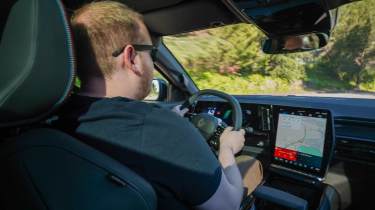
| Pros |
|
| Cons |
|
The Austral might have a sharp new look, but the far more important updates begin with new dampers, with the goal for the engineers being to improve ride comfort without sacrificing handling. The side mirrors have been redesigned to reduce wind noise, along with the addition of new door seals and laminated side windows. Finally, to help boost refinement further, there’s now more soundproofing under the bonnet, while fresh engine mounts and a recalibrated hybrid system are supposed to reduce vibrations coming into the cabin.
So has Renault’s hard work paid off? Before we answer that, it’s important to note that UK-spec cars will actually have a different suspension set-up to the model we drove on the international launch in Spain.
When it first arrived here, all but the entry-level Austral was fitted with Renault’s ‘4Control’ rear-wheel-steering system that helps with manoeuvrability at low speeds, and offers greater stability as the pace increases. It’s the reason why the Mercedes S-Class and other luxury cars use similar technology. The other benefit for the Austral is it added a multi-link rear suspension set-up.
Customers in mainland Europe will continue to get this feature with the new model, but Brits won’t. Instead, every version of the new Austral sold here will be equipped with a less sophisticated torsion-beam system that’s more than likely to affect the ride quality – which disappointingly seems to suffer from the same problems as before.
Even on the wonderfully smooth, practically blemish-free Spanish tarmac on the motorways around Barcelona, the new Austral fidgets more than a toddler at the cinema. Even at low speeds, the car is bobbing about. Rivals are simply more composed.
Performance, 0-60mph acceleration and top speed
| Model | Power | 0-62mph | Top speed |
| E-Tech 200 Full Hybrid | 197bhp | 8.4s | 112mph |
While acceleration feels smooth for the most part, and performance is respectable, with the 0-62mph dash dispatched in 8.4 seconds, it takes a while for the gearbox to shift up once you lift off the throttle, once again leaving us listening to that coarse engine note.
Although, as we’ve said many times before, Renault’s hybrid system does exceptionally good work in town, with the e-motor allowing you to glide around in silence. The Austral defaults to moving off under electric power, so it’s incredibly smooth when shuffling along in stop-and-go traffic.
When the three-cylinder engine comes to life, it sounds slightly gravelly. We often find this in cars with a similar motor, but it’s still not an especially pleasant sound, and we were often forced to listen to it in the new Austral, because the clutch-less automatic didn’t shift up when we were pottering along at around 30mph. And other than planting your foot, there’s no way to force it to change gear.
Town driving, visibility and parking
The ride in the updated Austral isn’t uncomfortable per se, but can become very bouncy at times, and you know when you’ve driven over a pothole or imperfection in the road, because the car feels like it's diving into them.
Drivers can adjust the strength of the regenerative braking on the go using paddles on the steering wheel, which is a handy feature that’s still unusual for a hybrid. It’s helpful in stop-start traffic, because increasing the regen means you can put more energy back into the battery, and in turn save more fuel.
Previously, top-of-the-range models also featured four-wheel steering, which was a benefit for anyone parking in a tight car park, because it shrunk the Austral’s 11.4-metre turning circle to just 10.1 metres. For context, that’s the turning circle you’d get in a supermini such as the Renault Clio.
This feature has since been dropped, making the Austral less manoeuvrable than a Kia Sportage, with its 10.9m turning circle. At least the steering is light, helping to ease the burden of the extra work you’ll have to put into slotting the Austral into a space, and the parking cameras are clear.
B-road driving and handling
We will admit that, on a twisty B-road, there’s not that much body roll through fast corners and during quick changes in direction. The light steering doesn’t inspire confidence, while the brake pedal lacks any initial bite. When you really press on the pedal, the transition between regenerative braking and the physical discs is seamless – or it would be, if it weren’t for the constant squeaking we experienced.
Speaking of which, the new Austral rides on fatter Michelin e.Primacy tyres, selected to help with road handling, but also boost fuel efficiency. Sound thinking, but they start screeching if you even graze the throttle through a corner, making a gentle drive along a country road sound like a car chase from The Sweeney.
Motorway driving and long-distance comfort
Despite all the measures to improve refinement in the new Austral, as soon as we got up to motorway cruising speed, we noticed wind noise coming from around those new, supposedly more aerodynamic mirrors. We also picked up a lot of vibrations coming up through the seats and steering wheel on the motorway, and road noise coming into the cabin, again, even on very smooth roads.
“Despite some well considered changes to the suspension system and other areas of the car, the Austral still suffers from an unrefined driving experience that will continue to hold back Renault’s otherwise solid family SUV.” – Ellis Hyde, news reporter, who drove the new updated Renault Austral on the international press launch in Barcelona, Spain.
MPG & running costs
| Pros |
|
| Cons |
|
In order to meet the demands of customers and compete with rivals, the Renault Austral has only ever been offered with a full-hybrid powertrain. However, most other mid-sized SUVs these days are available as a plug-in hybrid as well, which appeals to company-car drivers more due to better tax rates, but we’ve been told there are no plans to introduce an Austral PHEV.
Nevertheless, Renault says the Austral can average up to 60.1mpg, which is a good deal more efficient on paper than its closest competition, the Nissan Qashqai E-Power. That said, after covering more than 100 miles in the updated Austral on the car’s international launch, we had averaged less than 37mpg.
| Model | MPG | CO2 | Insurance group |
| E-Tech 200 Full Hybrid | 58.9-60.1mpg | 106-109g/km | 21E-23E |
Insurance groups
The cheapest Austral in the range to insure will be the entry-level Techno, in group 21, while (inevitably) the priciest Iconic Esprit Alpine will be the most expensive, in group 23. That’s a decent showing in the family SUV class compared with the Kia Sportage and Nissan Qashqai, which both sit in higher groups. However, our preferred Hyundai Tucson in mid-range hybrid Premium trim is only in group 19.
Tax
Low fuel consumption means low emissions. A CO2 output figure of just 106g/km for the Techno trim means a company-car driver will benefit from lower Benefit-in-Kind (BiK) tax than if they’d opted for the base petrol version of our favourite family SUV, the Hyundai Tucson. Having said that, an all-electric alternative, such as the Skoda Enyaq, will have an even lower company car tax bill.
At least every version of the Renault Austral is expected to cost less than £40,000, so it avoids the expensive vehicle supplement and your annual Vehicle Excise Duty (VED) or road tax bill will be just £195.
Depreciation
The Renault Austral is predicted to maintain around 54 per cent of its value over three years or 36,000 miles, according to our latest expert data, with entry-level Techno versions expected to hold the most value. For comparison, the Hyundai Tucson is expected to retain up to 59 per cent of its original value after the same period, depending on the model, and the Kia Sportage is projected to hold on to up to 58 per cent.
To get an accurate valuation on a specific model check out our free car valuation tool...
Renault Australs for sale

2025 Renault
Austral
17,565 milesAutomaticPetrol1.2L
Cash £22,499
2024 Renault
Austral
11,162 milesAutomaticPetrol1.2L
Cash £23,197
2025 Renault
Austral
12,493 milesAutomaticPetrol1.2L
Cash £22,900Interior, design & technology
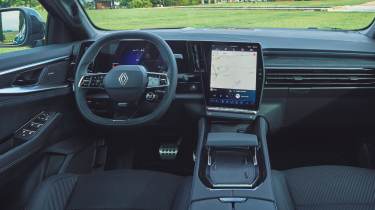
| Pros |
|
| Cons |
|
The Renault Austral’s original design didn’t quite align with the other models in the brand’s line-up, so the new facelifted version has a chiselled, more assertive look, inspired by the Rafale. Changes include unique bumper and grille designs, although these do incorporate some shared styling cues, particularly the arrow-like running lights. The bonnet and tailgate are also new, as are the slimmer tail-lights, which have an intricate pattern inside. Finally, there are fresh wheel designs for the ‘Esprit Alpine’ trims.
Interior and dashboard design
While the Austral’s exterior has been given a major makeover, the interior has hardly been touched, but that’s a good thing because it's always been one of this car’s redeeming areas – especially the Google-powered ‘OpenR Link’ infotainment system that remains among the best you’ll find in any car. It’s slick, intuitive to navigate and easy to use, and is running on a huge 12-inch portrait touchscreen, and another 12.3-inch display in front of the driver. Thankfully, you’re not forced to rely solely on the large touchscreen, however, because you still get a row of physical toggle switches for the climate controls running along the bottom.
Materials and build quality
The cabin still looks impressive, and there’s a decent amount of soft-touch materials dotted around, although we did detect some creaking coming from the dashboard trim in our factory-fresh test car. There’s a fair bit of piano black trim, too, which quickly attracts scratches and dust. It looks to be up to class standard in terms of quality, but hard plastics are used lower down on the dashboard and door cards, and the air vents are needlessly flimsy.
Infotainment, sat-nav and stereo
Every version of Austral comes with a 12-inch central touchscreen that runs an impressive Google-powered infotainment system called OpenR Link – the same system featured in the new Scenic E-Tech and Renault 5. Powering the large central screen is a speedy Qualcomm Snapdragon processor, which helps make this the slickest-running infotainment system we’ve yet come across in a Renault. Its fast reaction times to inputs are mirrored by the standard sat-nav mapping that’s provided by Google software.
It works superbly, with the voice control offering the usual intuitive integration we've come to expect from the software giant’s systems.
You can even control items in your home from the car using voice control.
The graphics are sharp, and the interface looks smart in areas where the Google link is obvious (mainly the mapping on both the main display and the digital dash). Overall, it’s one of the better infotainment systems in the class.
Now, the screens sport some new graphics, and more than 50 apps are now available through Google’s Play Store. Renault has also added a facial-recognition camera that allows the driver to quickly access their unique profile, which sounds fairly handy if you share your car. This feature will be coming to the UK early next year.
We’re yet to try the standard eight-speaker sound system, but the upgraded 12-speaker Harman Hardon system fitted to the range-topping models we’ve driven sounds excellent.
Boot space & practicality
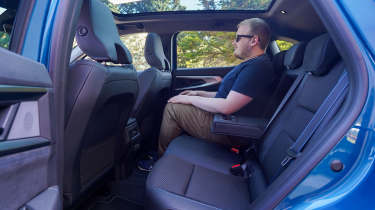
| Pros |
|
| Cons |
|
One of the few changes Renault made to the Austral’s interior during its sooner-than-expected facelift was adding some new ‘more ergonomic’ front seats that we found to be surprisingly uncomfortable. The hard base will make your bum ache after a long journey, and the passenger doesn’t get any adjustable lumbar support, either. Also, despite what looks like a sufficient amount of side bolstering, and Renault claiming the new seats have been designed to be more supportive, we felt ourselves moving around a lot through corners.
Dimensions and size
The Renault Austral measures 4,530mm long, 1,618mm tall and 1,825mm wide. So it’s bigger than a Nissan Qashqai, and even a Hyundai Tucson is marginally shorter but is taller and wider than the Austral – two facts that contribute to its Korean rival feeling bigger inside.
| Dimensions | |
|---|---|
| Length | 4,530mm |
| Width | 1,825mm |
| Height | 1,618mm |
| Number of seats | 5 |
| Boot space | 487-555 litres |
Driving position, seats & space in the front
Step inside the Renault Austral, and you’ll find a spacious driving position with plenty of head, leg and shoulder room. Lumbar adjustment is standard across the range, and from mid-range Techno Esprit Alpine upwards, you get electric front seat adjustment.
Chunky pillars may make it awkward for some to see out of the Austral at junctions. Fortunately for those who have to reverse onto a busy road, the Austral comes with rear cross-traffic alert, which warns you of approaching vehicles about to cross your path. Every Austral also comes with front and rear parking sensors to aid you in slotting it into a tight bay. The additional concave mirror is a neat touch so those in the front can watch their in-laws or children (or both) squabbling in the back.
The Austral has plenty of cubbies inside, with generous front door bins that have space for a large water bottle. The glovebox is a decent size, too, as is the cubby below the front armrest. Ahead of that is a sliding panel on the centre console, which houses a wireless phone charging pad on the top-spec Iconic Esprit Alpine. Put it in its forwardmost position, and it reveals a deep storage box, or pull it back to uncover a pair of cupholders just below the large portrait touchscreen.
Seats & space in the back
All versions of the Austral come with a sliding rear bench, just like the smaller Renault Captur and Symbioz. This can split in a 60:40 layout, and either section can move back and forth by up to 16cm independently of the other, so either boot space or knee room can be prioritised.
With the bench as far back as it goes, knee room is generous – even more so than the Kia Sportage. The outer seats are quite sculpted and supportive, plus they get ISOFIX mounting points. Curiously, the middle seat feels raised, and taller passengers sitting there will feel very close to the ceiling.
Boot space
The boot in the Austral is a useful square shape to make the game of packing Tetris much easier. There are some release handles for the seat back located just inside the boot entrance to make it a cinch to drop them when loading longer items. Again, they fold down in a 60:40 split.
Normally, the Austral offers 487 litres of boot space, but slide the rear bench forwards all the way and you get 555 litres to play with. That should be plenty for most people, but if space is a priority for you, the Tucson, Sportage or maybe Dacia Bigster will be a better fit.
The boot loading height of 805mm is another downside, because it’s one of the highest of any new car we’ve measured, and will be a real hindrance for any dog owners wishing to put their pet in the Austral. You get a couple of hooks to hold a small shopping bag, plus some underfloor storage – although the subwoofer fitted to top-spec Iconic Esprit Alpine takes up a significant portion of this compared with lesser models.
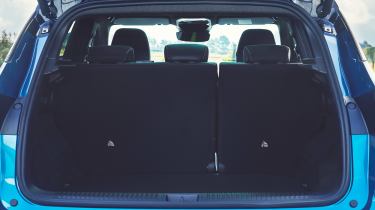
Towing
A towing capacity of 1,500kg for a braked trailer means you can pull a decent-sized caravan with the Austral. However, both the Hyundai Tucson and Kia Sportage, plus four-wheel drive versions of the Toyota RAV4, can tow more.
All versions of Austral come with hill hold assistance to lend a helping hand on tricky hill starts, plus there’s trailer stability assist to keep you on the straight and narrow should you encounter crosswinds.
“The sliding rear bench is a handy, practical touch, however there’s nothing to cover the void left when the rear seats have been moved forward, so stuff can easily roll down in between and get lost. We’re not sure why Renault doesn’t have a solution for this issue, as just a bit of extra carpeting would do the job.” – Ellis Hyde, news reporter, who drove the new updated Renault Austral on the international press launch in Barcelona, Spain.
Reliability & safety
| Pros |
|
| Cons |
|
One thing Renault did get right in the updated Austral was adding the My Switch button to the dashboard which allows the driver to activate personalised settings for the ADAS suite with just two quick prods.
Renault now boasts up to 32 advanced driver-assistance systems on board the Austral, but the main point is that this family SUV received the maximum five-star rating from safety experts Euro NCAP in 2022. It did better than the Alfa Romeo Tonale and Kia Sportage (both tested in the same year) in adult, pedestrian and safety assistance categories.
Every version comes with front and rear autonomous emergency braking (AEB), blind spot monitoring, lane departure warning, emergency lane keep assistance, and front and rear cross-traffic alert. The latter warns you of vehicles crossing your path, which is particularly useful when emerging between parked cars onto a busy road.
There isn’t much we can add about the Austral’s reliability because it is too new to have been included in the latest 2024 Driver Power survey. Renault as a brand didn’t do brilliantly, coming in 28th place out of 32 in the best car manufacturer rankings. That’s one place higher than its 2023 result, but owners' views of the positives and negatives of ownership have changed very little. They rated fuel economy and running costs as highlights, areas in which Austral excels.
They were less impressed with the interior of their cars, and this is an area where Renault could put some more work into the Austral. There are soft materials used on the dash, and a few neat metal finishes give it a premium look, but the hard plastics used in the lower sections of the dashboard look cheap, and the flimsy air vents undermine the feeling of quality compared with the likes of our preferred family SUV choice, the Hyundai Tucson. Another area of concern is the smoothness and performance of the engines, which is something we hope the early facelift of the Renault Austral will address, although the 1.2 engine in our test car in Spain sounded coarse at times.
| Key standard safety features |
|
| Euro NCAP safety ratings |
|
Renault Austral alternatives
The Renault Austral is a mid-sized SUV, meaning it competes against numerous highly popular, highly regarded family cars such as the Hyundai Tucson, Kia Sportage, Nissan Qashqai, Ford Kuga, Toyota RAV4 and Peugeot 3008, to name but a few.
The French model has its benefits, such as the fuel economy offered by its hybrid powertrain and the excellent Google technology onboard. However, it falls behind our reigning mid-size SUV champion, the Hyundai Tucson, in terms of its ride comfort and the smoothness of its gearbox.
What’s more, apart from the Nissan, all those rivals we mentioned are available with a plug-in hybrid powertrain, making them more appealing to company-car drivers. If you want to lower your Benefit-in-Kind (BiK) tax bill, the pure-electric Renault Scenic E-Tech is more deserving of your attention.
Deals on the Renault Austral and alternatives
Frequently Asked Questions
The Renault Austral offers a brilliant infotainment system, frugal hybrid power and decent levels of practicality, but these merits and others are overshadowed by a poor, unrefined driving experience. Rivals are better to drive, and are more practical, too.

